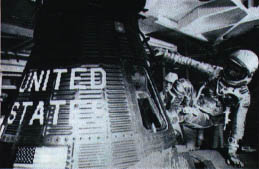| Mercury Project |
 |
Initiated in 1958, completed in 1963, Project Mercury was the United States'
first man-in-space program.The objectives of the program, which made six
manned flights from 1961 to 1963, were specific:
Subject of Mercury.
- To orbit a manned spacecraft around the Earth;
- To investigate man's ability to function in space;
- To recover both man and spacecraft safely.
 |
| Launch of mercury spacecraft |
|

|
| Astronaut John Grenn entering Mercury spacecraft |
|
Comparison between the Mercury Project and Space Shuttle Project
|
Mercury Project |
Space Shuttle Project (STS-95) |
| Space transportation |
Mercury Atlas |
Space Shuttle |
| Number of orbits around the Earth |
3 |
144 planned |
| Flight duration |
4 hours, 55 minutes, and 23 seconds |
scheduled for 8 days, 22 hours, and 4 minutes |
| Maximum acceleration of gravity |
approx. 8 G |
approx. 3 G |
| Landing site |
Atlantic Ocean, about 1300 km Southeast of Bermuda
Islands, by parachute |
Florida
NASA Kennedy Space Center Landing Facility (ranway)
|
| Weight |
approx. 1,928 kg (space ship) |
69,680 kg (orbiter) |
| Maximum number of crew |
1 |
7 |
| Living space |
1.02 m3 |
9.40 m3 (per person) |
| Cabin Pressure |
4.9 psi (Corresponding to 8,200m above sea level) |
14.7 psi (Corresponding to 0m above sea level) |
| Intraship air composition |
100% oxygen |
Oxygen 21% + nitrogen 79% (similar to the composition
of atmospheric air on the Earth) |
 |
Related links |
|
